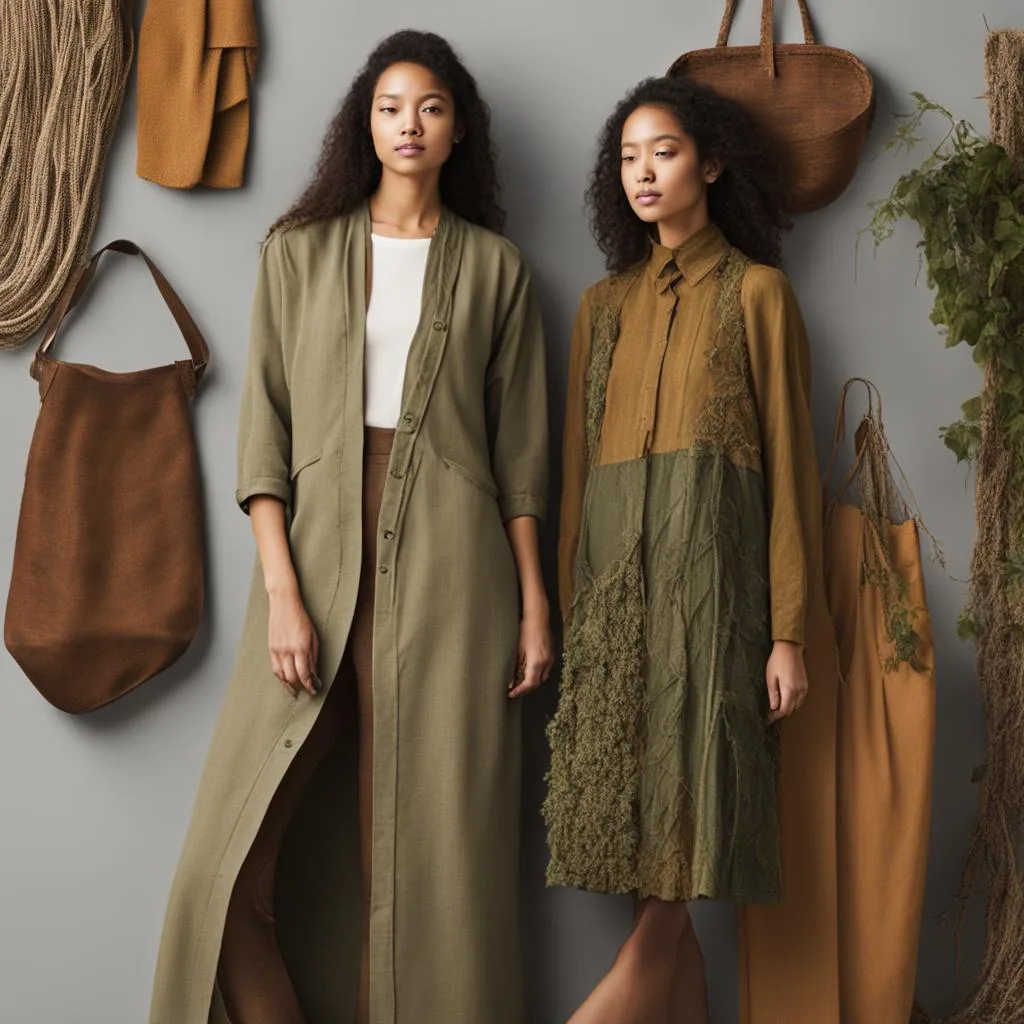Welcome to our guide on how to achieve a Sustainable Slay with eco-friendly style and ethical fashion. As conscious consumers, we all share the responsibility of reducing our impact on the environment and promoting sustainable practices. However, there are common habits that hinder our efforts to embrace sustainable fashion and lifestyle choices.
In this article, we will explore the top ten habits that undermine your sustainable style, and we’ll provide tips and insights on how to overcome these obstacles and build a wardrobe that aligns with your values and goals.
Key Takeaways
- Adopting sustainable habits is crucial for promoting eco-friendly style and conscious consumerism.
- Overcoming common habits such as impulsive shopping and neglecting secondhand options can lead to a more intentional and sustainable wardrobe.
- Supporting sustainable fashion brands and embracing clothing care and repair can also contribute to a more sustainable lifestyle.
- Ultimately, adopting sustainable practices and making ethical fashion choices can lead to a greener future for ourselves and the planet.
The Rise of Sustainable Fashion
At present, sustainable fashion is gaining more popularity than ever before, and it isn’t just a trend anymore. People are becoming increasingly conscious of their fashion choices and the impact they have on the environment. The idea of conscious consumerism has gained mainstream attention, and we can see that it has led to remarkable progress in the fashion industry’s eco-shift. Sustainable fashion today extends beyond using eco-friendly fabrics; it is now an approach of promoting ethical and sustainable production and consuming behavior.
As a result, designers and brands are adopting innovative techniques for manufacturing, packaging, and distributing products in a way that minimizes harm to the environment. Consumers, on the other hand, are now more likely to purchase from sustainable fashion brands , which are giving preference to sustainability and ethical production practices. By purchasing ethically made, environmentally friendly clothing, they can play a crucial role in contributing to the fashion industry’s socio-ecological transformation.
In addition to its impact on the environment, sustainable fashion also affects our lifestyles. It encourages us to embrace an eco-friendly style, which emphasizes buying fewer clothes and choosing pieces that will last longer. This approach promotes not only sustainable fashion but also a sustainable lifestyle .
The Importance of Conscious Consumerism
By being conscious consumers, we can make sure that the choices we make can go a long way towards improving the environmental impact of the fashion industry. We can take small steps like choosing clothes made from sustainable fabrics and those produced by sustainable fashion brands. By doing so, we contribute to creating a sustainable future.
| Key Takeaway | How it helps |
|---|---|
| Choose sustainable fashion | It minimizes the environmental impact of the fashion industry |
| Buy eco-friendly fabrics | It encourages the use of biodegradable and renewable resources |
| Embrace conscious consumerism | It promotes ethical and sustainable production practices |
“Our choices become our actions, our actions become our habits, our habits become our character, and our character becomes our destiny.”
As we become more aware of sustainable fashion’s importance, we can achieve significant progress in the fashion industry’s socio-environmental transformation. By spreading awareness and supporting sustainable fashion brands, we can contribute to creating a more environmentally conscious world.
Embracing Eco-Friendly Style
If you believe in sustainable fashion and conscious consumerism, it’s important to embrace eco-friendly style. This means making choices that are kind to the environment while looking fashionable and stylish.
| Eco-Friendly Elements | How it Helps |
|---|---|
| Organic cotton clothing | Uses less water, pesticides, and energy in production |
| Upcycling and repurposing old clothes | Reduces waste and promotes sustainable fashion |
| Sustainable fashion brands | Supports ethical practices and eco-conscious living |
| Thrift store/vintage shopping | Reduces consumption and contributes to the circular economy |
Incorporating these elements into your wardrobe not only reduces your environmental footprint but also supports ethical fashion practices. Remember, every small choice we make as conscious consumers contributes to a more sustainable future for all.
Looking for more tips on eco-friendly style and sustainable fashion? Check out this guide on eco-friendly fashion trends.
The Impact of Fast Fashion
Nowadays, fast fashion is a ubiquitous trend that emphasizes creating low-cost clothing quickly and inexpensively. Although it is very appealing to our wallets, fast fashion wreaks havoc on the environment. The production and transportation of disposable clothes significantly contribute to carbon emissions, toxic waste, and water pollution. Not only that, but fast fashion also exploits labor forces, promotes overconsumption, and produces an enormous amount of waste that ends up in landfills and oceans. As eco-conscious citizens, we must take action to reduce our impact on the planet.

One of the most effective ways to tackle the fast fashion epidemic is to choose sustainable fashion. Sustainable fashion emphasizes quality over quantity and uses environmentally-friendly materials and production methods that are ethical and fair. By reducing our consumption of disposable clothing and embracing sustainable fashion choices, we can mitigate the negative impact of fast fashion and promote a more eco-conscious lifestyle.
Habit 1: Impulsive Shopping
When we see a garment on sale or trending on social media, we often give in to the temptation of impulsive shopping. However, indulging in fast fashion trends not only harms the environment but also undermines our efforts to embrace sustainable fashion. Impulsive purchases can lead to overcrowding in our wardrobes, resulting in a lack of clarity and intentionality in our fashion choices.
To curb impulsive shopping and promote sustainable fashion, we suggest taking the time to identify the garments that complement our personal style and align with ethical and eco-friendly values. Investing in timeless pieces made with sustainable materials, such as organic cotton or recycled polyester, can add longevity to our wardrobe and contribute to conscious consumerism.
It’s also essential to evaluate the true cost of fast fashion and express our individuality through our fashion choices rather than conforming to trends. Suppose we allow ourselves to be influenced by the latest styles, without considering the environmental impact or labor practices of the brands we purchase from. In that case, we are not contributing to sustainable fashion or practicing conscious consumerism.
“We must cultivate a more conscious and intentional approach to fashion. By curbing our impulsive shopping habits, we can build a wardrobe that reflects our values and speaks to our sense of style.”
Neglecting Secondhand and Vintage Options
When it comes to sustainable fashion, secondhand clothing and vintage items are often overlooked. However, incorporating these alternatives can contribute to a more conscious and eco-friendly wardrobe.
By selecting secondhand and vintage pieces, we reduce the demand for new clothing and prevent items from ending up in landfills. Plus, it’s a fun and unique way to express our personal style while being environmentally conscious.
| Advantages of Secondhand and Vintage Clothing | How it Helps with Sustainable Fashion |
|---|---|
| Unique and One-of-a-Kind Pieces We can find unique and special items that no one else has, making our wardrobe truly unique. | Reduce Waste and Consumption By choosing secondhand and vintage clothing, we reduce the demand for new clothing and prevent items from ending up in landfills. |
| Affordable Secondhand clothing is often much more affordable than new clothing, allowing us to build a sustainable wardrobe on a budget. | Conserves Resources The production and disposal of clothing takes a toll on our environment, but choosing secondhand and vintage options helps conserve resources and reduce pollution. |
| High-Quality Materials Many vintage items were made from high-quality materials that are no longer used, making them more durable and longer-lasting than new clothing. | Supports Circular Fashion By choosing secondhand and vintage clothing, we contribute to a circular fashion economy where items are reused and repurposed instead of being discarded. |
So, the next time you’re looking to refresh your wardrobe, consider shopping secondhand or vintage options. You never know what hidden gems you’ll discover, and you’ll be doing your part to promote sustainable and ethical fashion.
Habit 3: Overwhelmed by Trends
It’s easy to get caught up in the latest fashion trends, but this habit can lead to a cycle of fast fashion consumption, which is detrimental to the environment. However, it’s also important to acknowledge that fashion trends can be fun and inspiring. How can we balance trends with sustainable choices?
One approach is to focus on timeless pieces that can be incorporated into multiple outfits and withstand the test of time. Embrace sustainable fashion by investing in high-quality, ethically-made pieces that are designed to last. Consider purchasing items that are verifiably eco-friendly, such as those made from organic cotton or recycled materials.
Another way to balance trends with sustainable fashion is by shopping at thrift stores or online secondhand retailers. By giving these pre-loved items a new lease on life, you can reduce your environmental impact and still indulge in the latest styles.

“Fashion is about dressing according to what’s fashionable. Style is more about being yourself.” – Oscar de la Renta
Remember, fashion is ultimately about expressing your individuality and personal style. By prioritizing sustainable fashion choices, we can create a more ethical and eco-friendly industry. Let’s lead the way in conscious consumerism and embrace truly timeless and sustainable style.
Habit 4: Disregarding Material Composition
How often do we think about the fabric of our clothes when we’re shopping? Not much, right? Yet, material composition plays a key role in sustainable fashion. By paying attention to the fabrics used in our clothes, we can make more informed choices and embrace an eco-friendly style.
Certain materials have a greater environmental impact than others and are harmful to produce and dispose of. Polyester, for example, is cheap and easy to produce, but it’s a synthetic material that doesn’t biodegrade and releases microplastics into the environment. On the other hand, materials like organic cotton, linen, and bamboo are more sustainable and biodegradable.
Additionally, understanding the composition of our clothes can help us care for them better, extending their lifespan and reducing waste. For example, clothes made of delicate fabrics like silk or wool may require specialized cleaning methods, while clothes made of synthetic materials can easily be damaged by high heat. By knowing how to care for our clothes, we can avoid unnecessary wear and tear and reduce our environmental footprint.
“Choosing eco-friendly fabrics is not only better for the environment but also for our own health. Synthetic materials can be harmful to our skin, causing allergies and skin irritations. Embrace sustainable fabrics and prioritize your health and the planet’s well-being.”
Let’s think beyond the appearance of our clothes and prioritize the materials they are made of. By selecting pieces made of sustainable, biodegradable, and eco-friendly materials, we can make a positive impact on the environment. Sustainable fashion isn’t just about how we look – it’s about responsible choices that benefit everyone and everything.
Habit 5: Ignoring Sustainable Fashion Brands
Do you find yourself always opting for the fast fashion brands you’ve grown used to? It’s time to break the habit and discover the wide range of sustainable fashion brands available to us.
By supporting ethical and environmentally friendly labels, we can contribute to conscious consumerism and advocate for a more sustainable fashion industry. Sustainable fashion brands prioritize the use of eco-friendly materials, fair labor practices, and ethical production methods.
Some of our favorite sustainable fashion brands include:
| Brand Name | Specialty | Price Range |
|---|---|---|
| Patagonia | Outerwear, activewear, and accessories | $-$$$ |
| Reformation | Women’s clothing and accessories | $$-$$$ |
| Everlane | Basic clothing and accessories for men and women | $-$$ |
It’s important to research and find sustainable fashion brands that align with your personal style, budget, and values. By investing in quality pieces from these brands, you can build a conscious and sustainable wardrobe.
“As consumers, we have the power to demand ethical and sustainable fashion choices. Let’s use that power to support brands that align with our values and contribute to a more responsible and transparent fashion industry.”
Habit 6: Neglecting Care and Repair
When it comes to sustainable fashion and eco-conscious living, clothing care and repair are crucial. Neglecting to take care of our garments can lead to them wearing out faster and ending up in landfills, contributing to the fashion industry’s waste problem. But by taking simple steps to care for and repair our clothes, we can extend their lifespan and reduce our environmental impact.
One essential clothing care practice is to read and follow care labels on our clothing items. These labels provide instructions on how to clean and maintain them properly, ensuring they stay in good condition for longer. Additionally, washing our clothes in cold water and air-drying them can be a more eco-friendly alternative to using a dryer, which consumes a lot of energy.
When our clothes do experience wear and tear, it’s important to repair them instead of automatically discarding them. Sewing on a button, patching up a tear, or re-soling shoes can easily be done at home or by a professional. Not only does it help save money in the long run, but it also contributes to sustainable fashion practices by reducing waste.
Caring for and repairing our clothes may seem like small steps, but they can have a significant impact on the environment and our sustainable fashion practices. Let’s embrace these habits and be mindful of the choices we make in our clothing care routine. By doing so, we can reduce waste, save money, and contribute to a more sustainable future.
Falling for Greenwashing
Greenwashing is the practice of making misleading or false claims about a product’s environmental or sustainability credentials. This is a common advertising tactic used by brands to make consumers believe they are making ethical and sustainable choices when in reality, they are not.
As conscious consumers, it is essential to conduct thorough research and identify truly sustainable fashion choices. We must not fall for the trap of greenwashing and instead support ethical and environmentally conscious fashion brands.
When shopping for sustainable fashion, be wary of buzzwords like “green,” “eco-friendly,” and “natural” as they are often used to deceive. Look for specific certifications such as the Global Organic Textile Standard (GOTS) or the Fair Wear Foundation (FWF) to ensure that the brand is genuinely ethical and sustainable.
Let us commit to being informed consumers and support brands that genuinely align with our values. Together, we can make a difference and promote sustainable fashion practices.
“As conscious consumers, it is essential to conduct thorough research and identify truly sustainable fashion choices.”
Conclusion
Congratulations on taking the first step towards a more sustainable and eco-friendly style! By understanding the ten habits that undermine sustainable fashion and making conscious choices, we can all contribute to a more sustainable future.
Remember, sustainability is about more than just the clothes we wear. It’s about our daily choices and their impact on the planet. Let’s embrace ethical fashion and eco-friendly style in all aspects of our lives.
Whether it’s choosing sustainable fashion brands, repairing and caring for our clothing, or incorporating secondhand and vintage options into our wardrobe, every little effort counts. Together, we can make a significant difference in creating a more sustainable world.
Let’s continue to educate ourselves and spread awareness about sustainability and its importance. With our collective actions, we can create a brighter future for generations to come.
Thank you for joining us on this journey towards sustainable slay! Let’s continue to make a positive impact on the world through conscious consumerism and ethical fashion.
FAQ
What is sustainable fashion?
Sustainable fashion refers to clothing that is produced and consumed in a way that minimizes harm to the environment and respects the rights of workers. It encompasses various principles, such as using eco-friendly materials, reducing waste, promoting fair labor practices, and supporting the longevity of garments.
Why should I embrace sustainable fashion?
Embracing sustainable fashion has numerous benefits. It allows you to reduce your environmental footprint, support ethical production practices, and contribute to a more sustainable future. Sustainable fashion also encourages you to develop a unique style, as it often offers innovative designs and options that differ from fast fashion trends.
How can I incorporate sustainable fashion into my lifestyle?
There are several ways you can incorporate sustainable fashion into your lifestyle. Start by evaluating your current wardrobe to identify sustainable pieces and donate or recycle any items you no longer wear. Consider shopping from sustainable fashion brands that prioritize eco-friendly practices. Additionally, make an effort to educate yourself on sustainable fashion and support ethical and environmentally conscious initiatives.
Are there affordable sustainable fashion options available?
Yes, there are affordable sustainable fashion options available. While some sustainable fashion brands may have higher price points due to their commitment to ethical production and quality materials, there are also affordable alternatives. Look for secondhand clothing, shop sales, and explore sustainable fashion collaborations or capsule collections that offer accessible prices.
How can I find sustainable fashion brands?
Finding sustainable fashion brands can be as simple as conducting an online search using keywords like “sustainable fashion” or “ethical clothing brands.” You can also browse websites and directories that curate sustainable fashion options. Look for certifications and labels like Fair Trade, GOTS (Global Organic Textile Standard), and B Corp, as these indicate brands that meet specific sustainability standards.
Can I still follow fashion trends while embracing sustainable fashion?
Yes, you can still follow fashion trends while embracing sustainable fashion. However, it’s essential to do it consciously and selectively. Instead of constantly buying trendy items that may go out of style quickly, consider investing in timeless pieces and accessories that can be styled in various ways. Opt for high-quality, versatile garments that you can wear for years, rather than falling into the cycle of fast fashion trends.
How can I take care of my clothes to make them last longer?
Taking care of your clothes is crucial to extending their lifespan and reducing waste. Follow the garment care instructions provided by the manufacturer, such as washing in cold water and air-drying when possible. Avoid overwashing and using harsh chemicals that can damage fabrics. Mend small repairs promptly and consider learning basic sewing skills to tackle larger repairs. Proper care can significantly increase the longevity of your garments.
What are some eco-friendly materials used in sustainable fashion?
There are several eco-friendly materials commonly used in sustainable fashion. These include organic cotton, hemp, linen, bamboo, Tencel (made from wood pulp), recycled polyester, and cruelty-free alternatives like Piñatex (pineapple fiber) and mushroom leather. These materials help reduce the environmental impact of clothing production by using fewer chemicals, water, and energy.
How can I avoid falling for greenwashing when shopping for sustainable fashion?
Falling for greenwashing can be avoided by conducting thorough research when shopping for sustainable fashion. Look beyond marketing claims and check if brands provide transparency about their supply chain, production processes, and certifications. Look for credible third-party certifications and do some background research on the brand’s environmental and social initiatives. Social media influencers, fashion blogs, and online communities focused on sustainability can also provide insights and recommendations.
Can sustainable fashion be stylish?
Absolutely! Sustainable fashion can be stylish and even more unique than fast fashion trends. Many sustainable fashion brands prioritize innovative design, creativity, and craftsmanship. By embracing sustainable fashion, you have the opportunity to curate a wardrobe that reflects your personal style while making a positive impact on the planet and supporting ethical practices.






